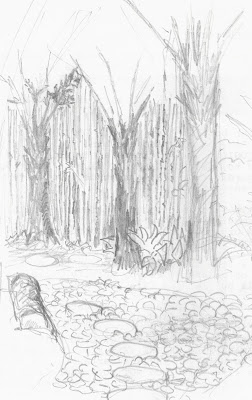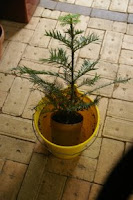
Today I came across some old sketches of my original ideas for the cretaceous garden. The first was perhaps a little ambitious, with a water feature and mini pier from the carport. However on the back of this sketch was an interesting hand written list-
suitable plants with cretaceous ancestors
- ferns
- moss
- cycads
- laurel (eg sassafras)
- cypress (low growing)
- deciduous beech
- ginkgo
- bamboo ??
The fact that I had included bamboo suggest that I had not researched this list well, if at all. Grasses, of which bamboo is one, didn't really evolve until until after the cretaceous (but more about bamboo later) I suspect it is on the list because it was already there in the garden.
I also has a second list of look-alike cretaceous plants
- broad leaf cover (eg aspidistra)
- pin cushion plant
Looking back that was a pretty good list to start, and matches what has flourished, I'm giving myself 7 out of 10 for plant selection (
now is that a B minus or a C plus on a standardized marking system?)


My second design is much closer to what I have created it has a dry creek bed of rocks instead of a pond. I left out the stepping stone and have a mini island instead.
You might like to see what the area looked like before it became cretaceous.










![Wollemi Pine [Wollemia nobilius] website](http://photos1.blogger.com/x/blogger2/1930/3564/240/362820/gse_multipart1061.jpg)

